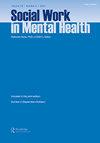将积极的青年发展纳入近期精神病发作的协调专业护理
IF 0.9
Q3 SOCIAL WORK
引用次数: 1
摘要
协调专科护理(CSC)在美国广泛实施,但高脱离率仍然存在。整合积极的青年发展方法(例如,过渡到独立过程(TIP)模型)可能会促进CSC的参与。TIP和CSC专家(n = 14)将TIP保真度量表与国际CSC保真度量表进行了比较。笔记是按主题编码的。为了更加了解pyd, CSC提供商可以:(1)重新定义恢复、参与和目标;(2)联合多学科工作人员采用与发展相适应的语言;(3)战略性地参与和扩大参与者的社会网络。研究结果为CSC供应商整合防止过早脱离的策略奠定了基础。积极的青少年发展实践可能可以整合到首发精神病的协调专业护理中。TIP模型的多阶段发展导向的未来规划过程和战略性社会支持参与可能促进CSC参与。TIP模型的优点在于将CSC团队中的多学科观点结合起来,促进团队协作和年轻人(以及家庭和其他相关支持人员)的参与。本文章由计算机程序翻译,如有差异,请以英文原文为准。
Integrating positive youth development into coordinated specialty care for a recent onset of psychosis
ABSTRACT Coordinated Specialty Care (CSC) for a recent onset of psychosis is widely implemented in the U.S., yet high disengagement rates persist. Integrating a Positive Youth Development approach (e.g., Transition to Independence Process (TIP) Model) may boost CSC engagement. TIP and CSC experts (n = 14) compared the TIP fidelity scale to an international CSC fidelity scale. Notes were thematically coded. To become more PYD-informed, CSC providers might: (1) re-conceptualize recovery, engagement, and goals; (2) adopt developmentally attuned language uniting multidisciplinary staff; and (3) strategically involve and expand participant social networks. Findings lay groundwork for CSC providers to integrate strategies to prevent premature disengagement. Takeaways Positive Youth Development practices likely can be integrated into Coordinated Specialty Care for first-episode psychosis. The TIP Model’s multi-phase developmentally focused futures planning process and strategic social support involvement may boost CSC engagement. The TIP Model holds merit for uniting multidisciplinary perspectives on CSC teams, promoting team collaboration and young person (and family & other relevant supportive people) engagement.
求助全文
通过发布文献求助,成功后即可免费获取论文全文。
去求助
来源期刊

Social Work in Mental Health
SOCIAL WORK-
CiteScore
1.90
自引率
0.00%
发文量
34
期刊介绍:
Social Work in Mental Health is an exciting contribution from the editors of our highly respected journal, Social Work in Health Care. This journal offers quality articles on clinical practice, education, research, collaborative relationships, mental health policy, and the delivery of mental health care services. This scholarly, creative, and lively journal presents material valuable to social workers in all sectors of mental health care. It is devoted to social work theory, practice, and administration in a wide variety of mental health care settings. Social Work in Mental Health will help you improve your practice in these areas, demonstrating the vital role of social services in mental health care delivery systems.
 求助内容:
求助内容: 应助结果提醒方式:
应助结果提醒方式:


